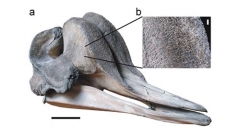

 Comptes Rendus Palevol
10 (5-6) - Pages 453-468
Comptes Rendus Palevol
10 (5-6) - Pages 453-468As compared to other odontocetes (toothed whales), the rostrum of beaked whales (family Ziphiidae) often displays extensive changes in the shape, thickness, and density of its constituent bones. Previous morphological observations suggested that these modifications appeared in parallel in different ziphiid lineages. However, very few data were available on the compactness and histology of these rostral bones, which precluded the study of the processes at work for the development of such structures, as well as the interpretation of their functional implications. In this work we review the bibliographic data on the anatomy of the ziphiid rostrum and we add new observations on adults of several extinct and extant taxa. These observations are based on CT scans and transverse histological sections. Our results confirm that different bones (vomer, mesethmoid, premaxilla, maxilla) are involved in the various morphologies displayed by ziphiid rostra. Strong density contrasts are detected between bones and/or inside the bones themselves; for example, parts of the rostrum reach densities in the range of Neoceti ear bones, which are among the densest bones known hitherto. Furthermore, the histology of the pachyostotic and osteosclerotic bones proves to change from one taxon to the other; the degree of Haversian remodeling varies strongly between species: it can be absent (e.g. Aporotus recurvirostris), partial (e.g. aff. Ziphirostrum), or complete (e.g., Mesoplodon densirostris). The atypical secondary osteons known to be responsible for bone hypermineralization in the rostrum of M. densirostris occurred also in Choneziphius sp. Confronted with a phylogenetic framework, these anatomical and histological observations indicate that the acquisition of compact (osteosclerotic) and/or swollen (pachyostotic) bone is the result of a broad convergence between taxa, in response to common selective pressures. The functional dimension of this question is discussed with respect to what is known about extant ziphiid ecology.
Odontoceti, Ziphiidae, Beaked whales, Pachyostosis, Osteosclerosis, Computed tomography, Bone histology